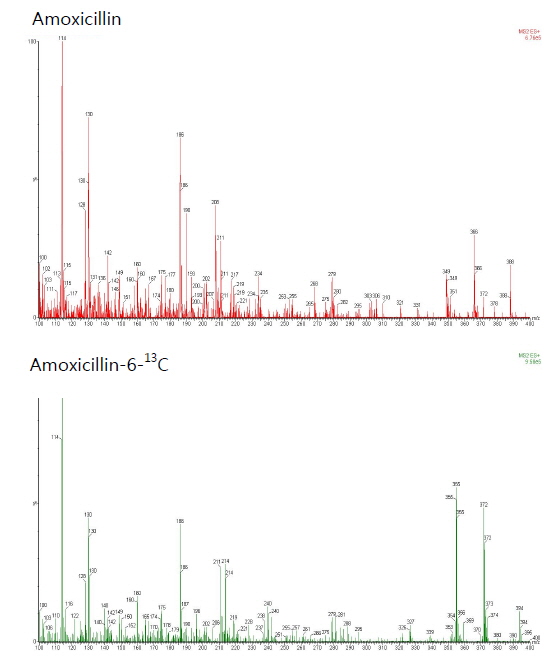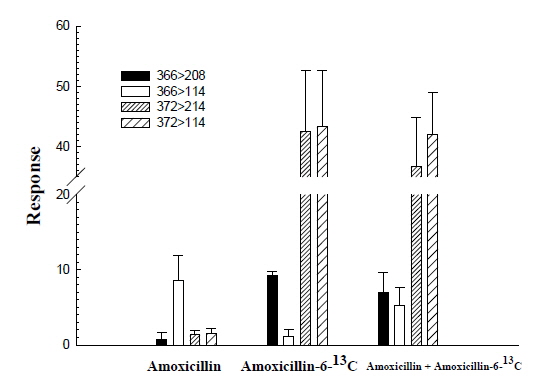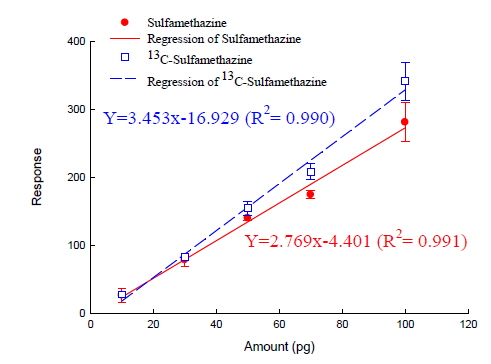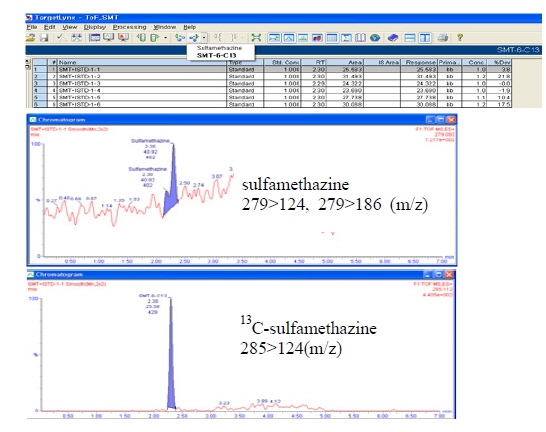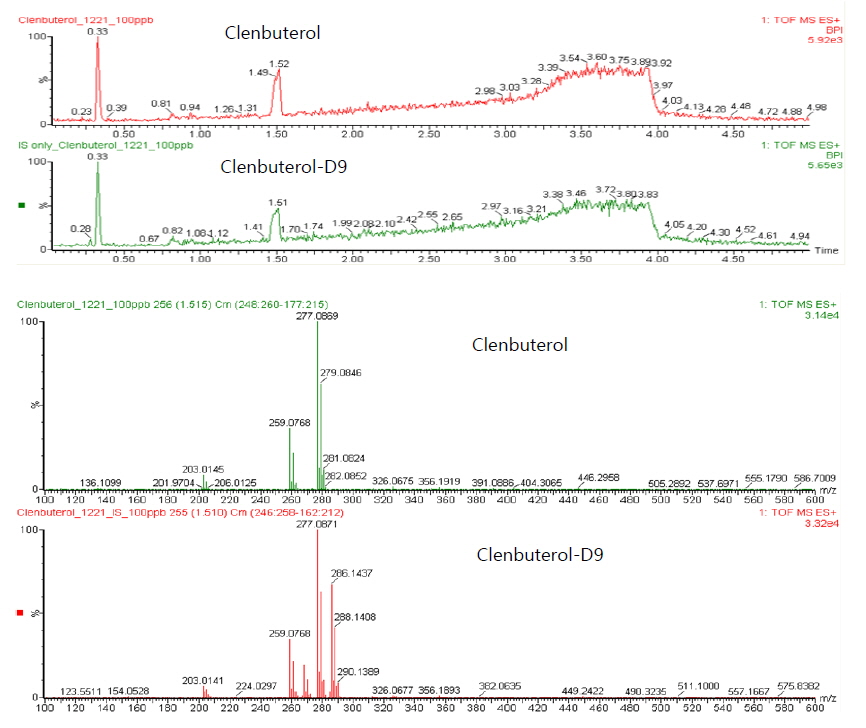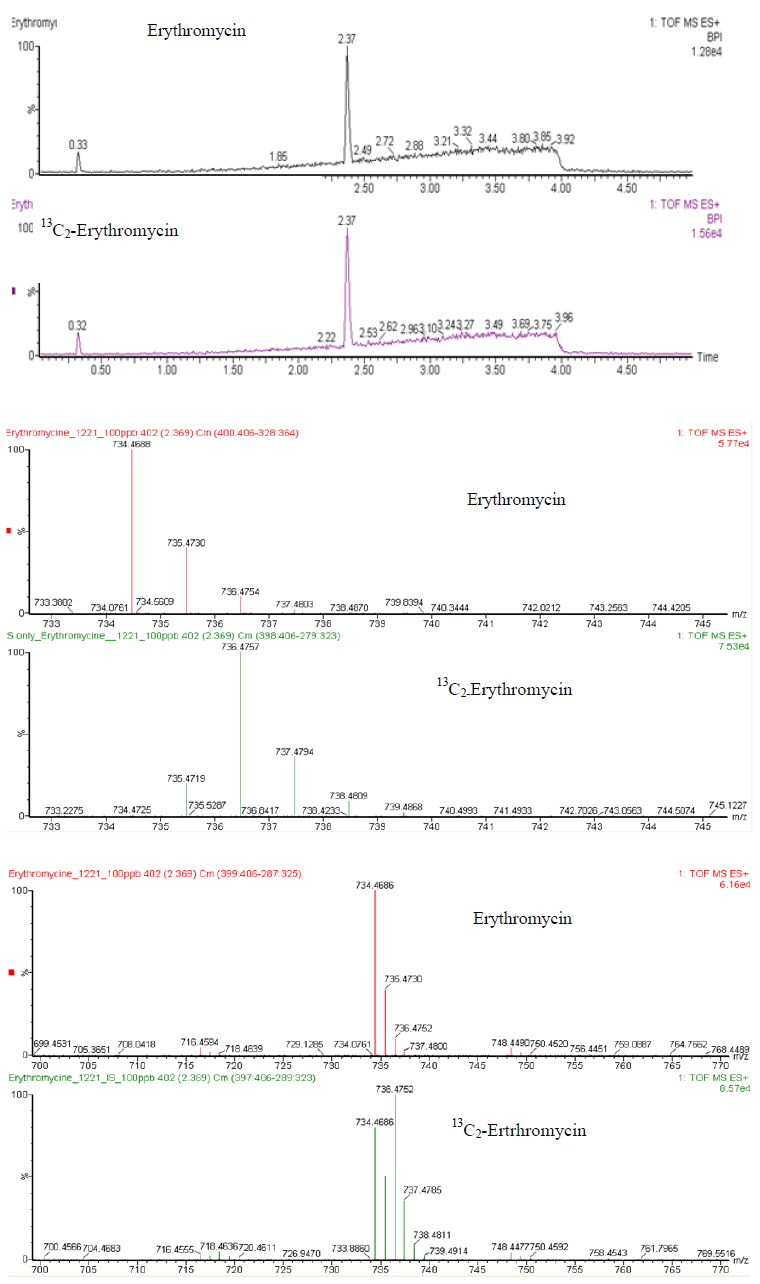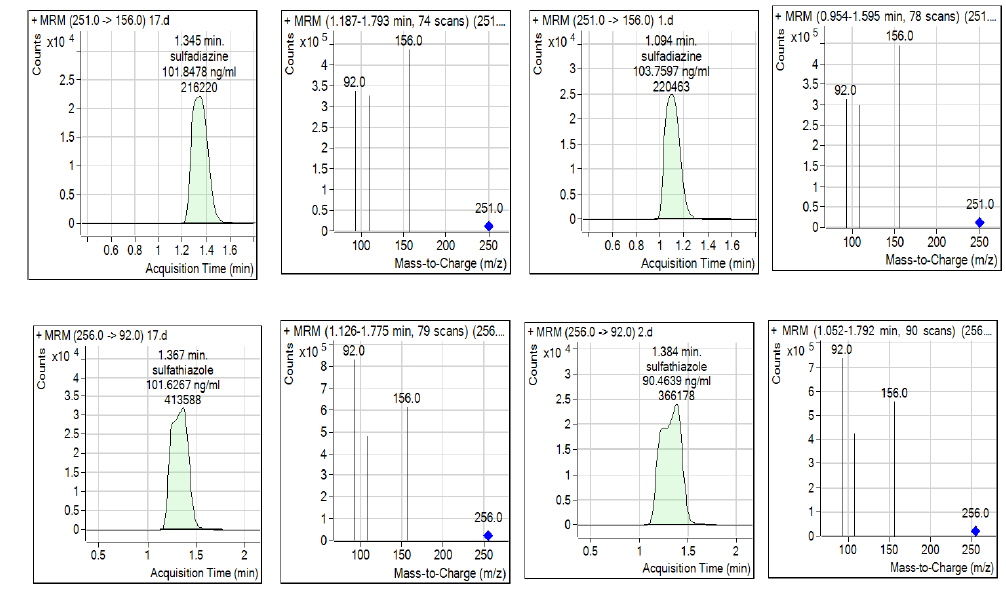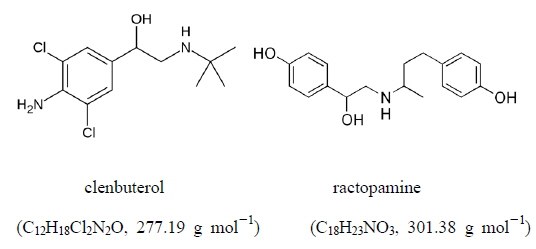



우리나라는 1989년 12월 보사부 고시 제 89-67호로 식육 중 항생물질, 항균제, 성장보조제의 잔류허용 기준이 설정된 이후로, 축산식품 중 동물용의약품 잔류분석은 미생물을 이용한 스크리닝, 박층크로마토그래피, 액체크로마토그래피, 질량분석기 등 과학기술의 발전과 함께 개선 진보되어 왔다. 이와 함께 잔류농약의 분석도 가스크로마토그래피와 액체크로마토그래피 기술을 이용한 정량 뿐 만 아니라, 질량분석기를 이용한 정성도 널리 활용되고 있으며, 국가 공인시험법은 아니지만 액체크로마토그래피/질량분석기 기술이 기반인 QuEChERS (Anastassiades
특히, 최근 널리 범용화 된 UPLC 또는 UHPLC (ultra-high performance liquid chromatography)와 LC/MS/MS는 분석시간의 단축, 적은 시료와 추출 용매의 절약, 극미량에서의 고감도 검출 등 많은 장점을 가지고 있지만, 크로마토그램간의 머무름 시간의 근접성, 분석 시료의 낮은 대표성, 분석자의 데이터 해석 숙련도와 판단력 등이 요구되는 실험실 내의 현실적인 문제도 안고 있다. 이러한 현실적인 문제에도 불구하고, UPLC/MS/MS를 이용한 의약품 및 동물용의 약품의 분석은 안정동위원소 (stable isotope)를 내부표준물질로 하는 분석 방향으로 지속적으로 개발되고 있다. 안정동위원소를 이용한 대표적 분석법은 가스크로마토그래피/질량 분석기를 이용한 PCDD/DFs의 동위원소희석법이 대표적인 예이며, 중금속류의 분석을 위해 ICP/MS의 분석에도 이러한 기법들이 도입되어 다양한 연구가 이루어져 왔다. 그런데, 이러한 안정동위원소 내부표준물질은 원래의 분석 대상물질과 분자량에 있어 큰 차이가 없고, 크로마토그램에서 동일한 머무름 시간을 가지며, 질량분석기내에서의 이온화과정, 질량분석기의 유형 및 해상도, 분석 대상 매질의 특성 등이 다양한 분석환경 내의 방해요소로 작용함으로써, 분석의 정확도를 떨어뜨리는 요인이 될 수도 있다. 더욱이 최근 우리나라에서도 널리 쓰이는 삼단사중극자형 질량분석기(triple quadrupole mass spectrometer)를 이용한 정량기법인 Multiple Reaction Monitoring (MRM) 또는 Selective Reaction Monitoring (SRM)에서 발생하는 부정확 한 분석의 사례로, cross-talk, ion suppression, 안정동위원소의 내부표준물질 사용에 따른 영향 등이 LC/MS/MS 뿐만 아니라, GC/MS/MS, ICP/MS 등에서도 나타난다고 보고됨에 따라 (Nischwitz and Pergantisa, 2006; Hughes
본 연구의 목적은 최근의 크로마토그래피/질량분석기의 사용추세인 UPLC/MS/MS와 UPLC/TOF (time of flight) 등을 이용한 동물용의약품의 잔류분석과정 중 기기적 특성에 의한 정성 및 정량의 오류, 또 안정동위원소의 내부표준물질로서의 활용의 적정성, 동일계열 유사구조 화합물의 동시분석시 이온화에 의한 동일한 precursor ion이 존재함에 따른 분석오류 등을 확인함으로써, 분석의 신뢰성을 높이는 기초자료를 제공코자 한다.
분석기기로 UPLC/MS/MS는 Acquity UPLC-Xevo Q (Waters Corporation, US)와 Agilent 1290 Infinity, Agilent 6430 Triple Quadrupole LC/MS Systems (Agilent Technologies, US)을, UPLC-TOF는 Acquity UPLC-Synapt G2 HDMS (Waters Corporation, Milford MA, US)를, 표준품은 Fluka production GmbH (Buchs, Switzerland)의 Ph Eur급의 clenbuterol, clenbuterol-D9, erythromycin, erythromycin-2-13C, sulfamethazine, sulfamethazine-6-13C과 sulfadiazine, sulfathiazole 등을 포함한 14종 sulfonamide 계 항균제를, acetonitrile 등 유기용매는 J.T Baker의 잔류분석용을 사용하였다.
기기분석은 C18 ACQUITY UPLC BEH (100x 2.1 mm; particle diameter 1.7 μm, Waters Corporation, Wexford, Ireland) 칼럼을 이용하여, 0.1 % formic acid/water and 0.1 % formic acid/MeCN 등 용리조건을 조정하여, ESI (electrospray ionization) positive로 분석하였으며, 데이터는 Masslynx, Targetlynx (Waters Corporation, Milford MA, US)와 MassHunter Workstation Software (Agilent Technologies, US)를 이용하여 수집 분석하였다.
높은 해상도의 질량분석기가 발달함에 따라, 과거 공시험 시료에 분석대상 화합물을 직접 주입하여 회수율을 확인하는 분석법들이, 안정동위원소를 내 외부표준물질로 이용하는 분석법으로 점차 확대되어가고 있다. 1980-1990년대 초반의 LC/MS 기술은 GC/MS로 직접적인 분석이 불가능한 극성물질과 유도체화 없이도 직접적으로 분석할 수 있다는 장점이 분석자들에게 큰 반향을 불러일으켰다. 그런데, 1990년에서 최근까지는 LC/MS 사용자가 증가함으로써 다양한 개선 사항들도 나타났는데, 대표적인 예가 이온화 효율의 현저한 저하로 인해 극성이 매우 높은 화합물들은 분석이 어려워, 결국 유도체화나 post-column 등이 대안으로 제안되어 활용되고 있다. 더불어, LC/MS의 사용에 있어 가장 큰 문제점으로 매질의 영향 (matrix effect)에 의한 ion suppression 임을 많은 연구자들이 보고하고 있다 (Antignaca
안정동위원소의 내부표준물질로의 적합성 및 정성 정량에 미치는 영향을 확인코자 amoxicillin과 amoxicillin-6-13C에 대해 Table 1의 분석조건으로, 표준품만으로 scan mode와 MRM mode에서 조사하였다. Fig. 1은 amoxicillin과 amoxicillin-6-13C에 대한 scan mode의 질량스펙트럼으로, TOF 등과 같은 고해상도가 아니므로, 스펙트럼간의 m/z의 확연한 차이는 발견할 수 없었고, 각 화합물의 precursor ion인 366과 372 (m/z) 각각에 대해 114 (m/z)의 높은 intensity를 나타내는 product ion을 공통으로 가지는 것이 확인되었다. 이는 MRM 방식에서 product ion을 정량이온으로 선정할 경우, 컬럼으로부터 분리되어 나오는 머무름 시간이 거의 같기 때문에 product ion 114 (m/z)가 amoxicillin과 amoxicillin-6-13C 중 어디로부터 유래한 것인지를 구분할 수 없는 요인이 된다. Fig. 2는 이를 확인하기 위하여 표준품만으로 amoxicillin 5 μg, amoxicillin-6-13C 5 μg, amoxicillin+amoxicillin-6-13C: 2.5+2.5 μg 으로 조제하여 각각 분석한 결과이다. 그 결과 표준편차는 크지만, 평균적으로 amoxicillin-6-13C의 372>114 (m/z)가 amoxicillin의 366>114 (m/z) 보다 월등히 크고, 각각의 1/2 함량을 혼합조제하여 분석하였을 경우 amoxicillin-6-13C과 유사하게 나타남으로써, 분석대상매질이 없는 표준물질만으로도 안정동위원소의 내부표준물질 사용이 분석결과에 영향을 미칠 수 있는 가능성이 확인되었다.
[Table 1.] MS/MS parameters for analytes and internal standards of amoxicillins

MS/MS parameters for analytes and internal standards of amoxicillins
더불어 Fig. 3의 sulfamethazine과 13C-sulfamethazine의 검량선의 기울기를 통해서도 이러한 유사한 경향이 확인되어, 기기운영 및 데이터 수집 프로그램 등을 통해 확인해 본 결과 Fig. 4와 같이, 두 화합물이 섞여있는 경우 해상도가 높은 TOF 분석기로 분석한다 하더라도 공통 product ion인 124 (m/z)가 13C-sulfamethazine과 sulfamethazine 중 어디로부터 유래한 것인지 구별할 수 없음이 확인되었다. 이러한 현상은 특정회사 프로그램만의 문제가 아니며, LC/MS/MS의 다양한 회사별 기종이 동일한 상황인 것도 확인되었다.
Cross-talk은 삼단사중극자형 질량분석기 (triple quadrupole mass spectrometer)를 이용한 정량기법인 MRM 또는 SRM에서 주로 발생하는 것으로 같은 product ion을 가지는 분석대상화합물들이 있을 경우 두 번째 대상화합물의 두 번째 전이가 측정되기에 앞서, 첫 번째 분석대상화합물이 삼단사중극자에서 불완전한 product ion의 소멸을 일으킬 때 의양성의 결과를 유도하는 것으로 알려져 있으며 (Nischwitz and Pergantisa, 2006), 시판되고 있는 근연화합물들의 혼합표준품을 이용하여 다성분분석을 할 때도 구조적 유사성 때문에 일어나는데 MRM방식에서 두 개의 전이 이온을 정성과 정량에 이용하고, 머무름 시간을 보정하면 이런 문제는 줄일 수 있다는 보고도 있다 (Song, 2011).
Fig. 4와 같은 현상은 Fig. 5와 6에서처럼 해상도 >10,000이상에서 exact mass를 정성하는 TOF의 분석 방식을 통해, 개별 각각의 clenbuterol과 clenbuterol-D9, Erythromycin과 13C2-Ertrhromycin은 구별할 수 있지만, 이들 스펙트럼을 통해 얻은 product ion의 공통되는 현상이 Table 2와 같이 요약 될 수 있어, 낮은 해상도에서 운용되는 실제 MRM 방식에서는 동일한 머무름 시간을 같는 유사한 질량 대 전하비(m/z)는 구별할 수 없는 현실적인 문제도 확인되었다. 아울러 안정동위원소의 경우, 13C2, D9 등 어느 안정동위원소이건 이러한 현상은 동일하게 일어날 수 있음이 확인되었다.
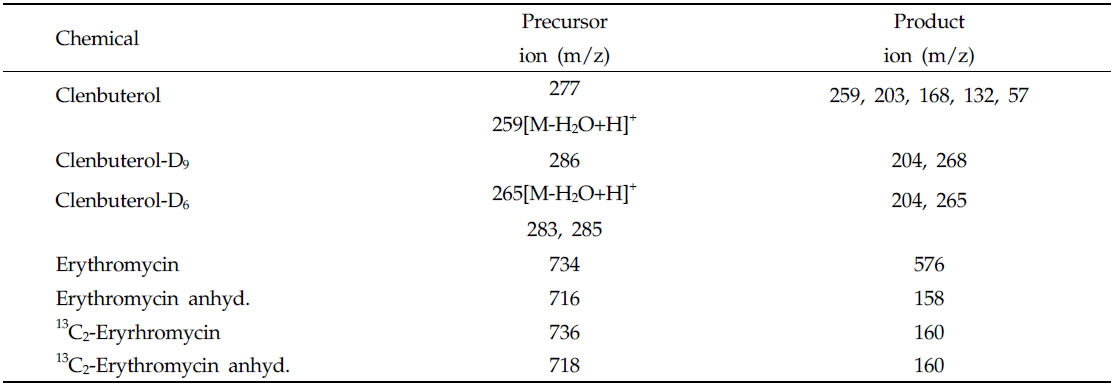
Precursor and product ions for cross-talk identification of clenbuterol, erythromycin and their isotope labelled internal standards by LC-TOF (Time Of Flight) analysis
구조적으로 유사하여 계열로 구분된 대표적 화합물인 sulfonamide계 의약품들을 대상으로, 동일한 product ion이 있을 경우 안정동위원소를 내부표준물질로 이용하였을 경우와 비슷한 현상이 일어나는지 확인코자 하였다. Table 3은 우리나라 식품공전에서 정한 sulfonamide계 14종에 대한 LC/MS/MS를 이용한 다성분 동시 분석에 적용되는 확인, 정량이온을 나타낸 것으로 (식품공전, 2014), 서로 다른 precursor ion임에도 불구하고 동일한 product ion을 정량이온으로 설정하여 분석토록 되어있다. 이들 각각 14종 화합물은 안정동위원소 내부표준물질과는 달리 액체크로마토그래프를 통해 분리 될 때 서로 다른 머무름 시간을 가진다. Fig. 7은 sulfadiazine과 sulfathiazole간 동일한 product ion이 존재할 때, 정성 및 정량에 미치는 영향을 확인 한 결과로 어떤 product ion을 정량 또는 정성에 적용하느냐에 따라 머무름 시간 1.09인 sulfadiazine (251>156 m/z)이 머무름 시간 1.34인 sulfathiazole (256>156 m/z)의 영향으로, 다른 머무름 시간의 이온을 sulfadiazine의 이온으로 인식하는 결과를 나타낸 것이다.
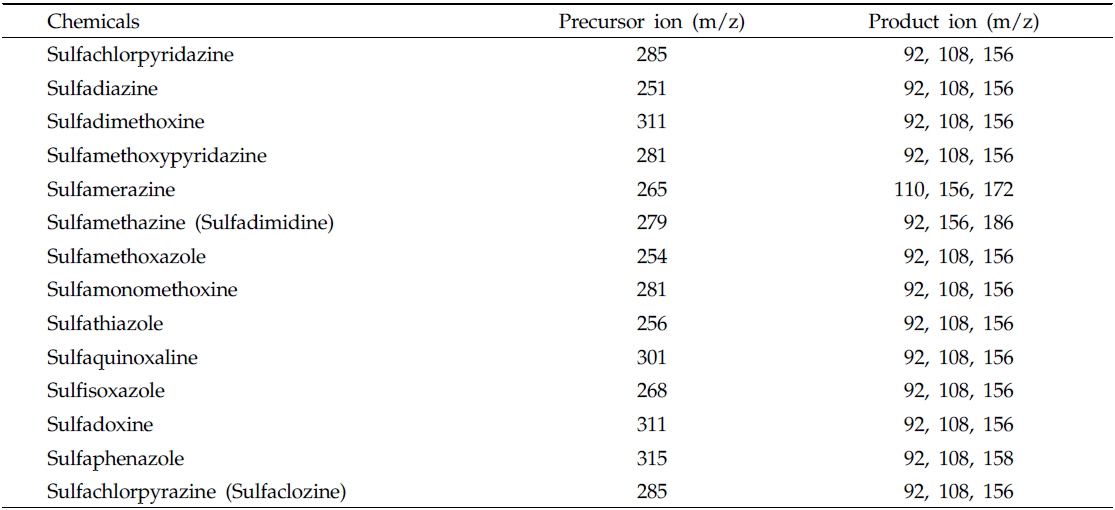
Precursor and product ions of 14 sulfonamide antimicrobials for residue analysis by LC/MS/MS Multiple Reaction Monitoring
이러한 현상은 MRM 분석의 scan 시간 조정을 통해 극복할 수 있다 (Nischwitz and Pergantisa, 2006)고 하지만, 질량분석기의 신호 수집에 따른 데이터 해석과정, 특히 대부분의 질량분석기 프로그램에 있는 smoothing 기법(Savitzky and Golay, 1964)의 충분한 이해 없이 peak를 해석할 경우 주로 발생할 수 있다. 이러한 구조적 유사화합물의 경우로, 모화합물과 분해대사산물, 동일계열의 화합물, 그리고 구조적 차이가 있음에도 product ion이 같은 경우, 예로 분석 시 머무름 시간이 근접할 때의 diclovos (141>79 m/z)와 captapole (151>79 m/z) 등을 들 수 있으며, GC/MS/MS, LC/MS/MS, ICP/MS 등 질량분석기와 연결된 inlet의 종류와 상관없이 발생한다. 더욱이 이러한 현상들은 표준용액의 분석 보다, 실제 시료 분석과정에서 매질에 의한 영향을 받을 경우 더욱 두드러지게 나타나는데, cross-talk 현상에 대한 이해가 없어 해석이 잘못된 크로마토그램들은 학술지에서 종종 쉽게 찾아볼 수 있다. 특히, 이러한 분석결과들은 식품 및 환경 중 동물용이나 인체용 의약품의 질량 분석결과에서 자주 접할 수 있는데, 안정동위원소를 내부표준물질로 이용하여 분석할 때 cross-talk에 의한 잘못된 정성 및 정량이 이루어 질 수 있는 대표적인 사례로서 clenbuterol과 ractopamine (Table 4, Fig. 8), nitrofuran계 대사물질 분석 즉, furaltadone의 AMOZ (3-amino-5-morpholinomethyl-2-oxa-zolidinone), furazolidone의 AOZ (3-amino-2-oxazolidinone), nitrofurantoin의 AHD (1-aminohydantoine), nitrofurazone의 SEM (semicarbazide)을 유도체화하고, 안정 동위원소를 내부표준물질로 사용하는 경우를 들 수 있다.

Precursor and product ions of clenbuterol, ractopamine and their stable isotope compounds for residue analysis by LC/MS/MS Multiple Reaction Monitoring (MRM)
질량분석기의 MRM/SRM, 또는 SIM/SIR의 기법은 scan 기능에서 낮은 감도로 확인 할 수 없는 물질의 감도를 높이고, 동일 머무름 시간 대에서, 확인 정량코자하는 이온만을 선택적으로 분석함으로써 유해물질의 안전관리에 큰 기여를 해왔다. 반면, 분석자에게는 특정 이온들의 존재와 비율만을 확인함으로써 그 물질의 존재를 지나치게 확신시키는 오류도 제공하고 있다고 판단된다. 따라서 LC (GC)/MS/MS의 MRM/SRM 기법 및 LC (GC)/TOF 등을 이용한 정성 및 정량의 오류를 줄이기 위해서는 가) 내부 표준물질로 이용되는 안정동위원소의 순도 확인, 나) 내부표준물질로서 안정동위원소 사용 시 농도 조절을 통한 검출예상 물질에 미치는 영향을 최소화할 것, 즉 검출 예상 농도 수준을 고려하여 과한 내부표준물질의 농도가 검출농도에 영향을 주지 않도록 할 것, 다) 칼럼을 통해 발생되는 carry-over의 방지, 라) 분석대상 매질의 영향 (matrix effect)에 의한 ion suppression 최소화, 마) 유사 구조 화합물 분석 시 머무름 시간, precursor ion과 product ion의 상호 확인, 바) smoothing 등 데이터 수집 및 해석프로그램의 충분한 숙지 등을 통한 정밀한 데이터 해석 등이 요구된다. 새로운 기술의 질량분석기를 이용하여 많은 대상 약제를 동시에 분석하는 것은, 규제 대상 이외 약제도 검출정량함으로써 위해요소의 사전 예방이라는 큰 장점을 가지고 있다. 이를 위해, 분석대상 시료의 특성과 대상 약제선정 등이 분석 목적과 분석기술 수준과도 잘 부합되고, 분석자의 숙련도와 전문성 의존도는 낮으면서, 높은 재현성과 반복성을 갖춘 시험법 개발이 분석오류를 줄여가는 데 큰 역할을 할 것으로 판단된다.


